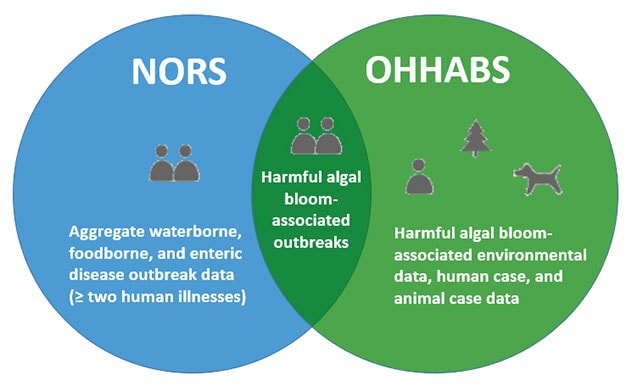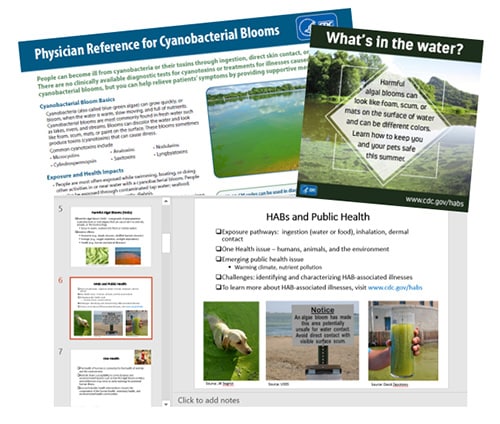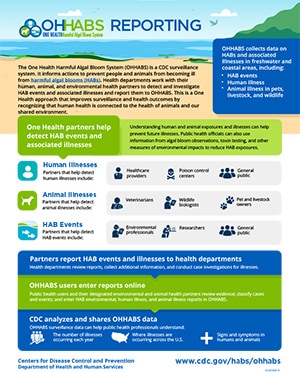Using OHHABS

The One Health Harmful Algal Bloom System (OHHABS) collects information to help CDC and partners better understand harmful algal blooms (HABs) and help prevent human and animal illnesses caused by HABs. OHHABS is a voluntary reporting system available to state and territorial public health departments and their designated environmental health or animal partners. Staff at agencies that report to OHHABS can use the resources below to collect and report information in OHHABS.
Download the OHHABS Reporting Infographic [PDF – 1 page] for more information about how OHHABS data are collected and used.
Forms
Report information in OHHABS by either directly entering information into the online system or importing PDF forms. Use the PDF forms below to collect and import information about harmful algal blooms (HABs) and associated illnesses in humans and animals. Use the fillable forms if you want to fill out PDF forms electronically. You can print and fill out the static PDF forms by hand. Read the instructions for importing fillable or static PDF forms [PDF 9 pages].
These forms can be used by partners without direct access to OHHABS to collect and share information with people who report in OHHABS.
| Form Type | Fillable Forms | Static Forms |
|---|---|---|
| HAB Use this form to report HABs in water bodies or information about the most likely food source for foodborne illnesses. Note: HABs can be reported even if no human or animal cases of illness have been associated with the HAB. |
Environmental Form (fillable) [PDF – 4 pages] | Environmental Form (static) [PDF – 4 pages] |
| Human Case of Illness Use this form to report individual cases of human illness. Note: If multiple people became ill following exposure to a HAB, please submit a report to both the National Outbreak Reporting System (NORS) and OHHABS. NORS is used to report at the level of an outbreak (two persons linked epidemiologically by time, place, or exposure). Data are reported to NORS in aggregate; data are reported to OHHABS for individual cases. |
Human Case Form (fillable) [PDF – 6 pages] |
Human Case Form (static) [PDF – 6 pages] |
| Animal Case of Illness Use this form to report individual or multiple cases of animal illness, including cases in:
Note: You can report animal cases of illness individually (e.g., single dog, single sea lion) or at the group level for multiple animal cases (a fish kill, a herd of cattle, a flock of birds). You can indicate whether you are reporting a single case or a group of animal illnesses. Where possible, single case reporting is preferred. |
Animal Case Form (fillable) [PDF – 5 pages] | Animal Case Form (static) [PDF – 5 pages] |
| Technical Assistance | Use this document to help you: |
|---|---|
| Signing In and Getting Started [PDF – 19 pages] |
|
| Navigating Reports [PDF – 19 pages] |
|
| PDF Import Guidance [PDF – 9 pages] |
|
| Public Health Assessment Tools | Use this document to: |
|---|---|
| Public Health Assessment Tool – Human Case [PDF – 6 pages] | Assess whether a human illness was likely caused by exposure to a HAB before reporting in OHHABS. |
| Public Health Assessment Tool – Animal Case [PDF – 6 pages] | Assess whether an animal illness was likely caused by exposure to a HAB before reporting in OHHABS. |
| Event and Case Definitions | Use this document to: |
|---|---|
| HAB Event, Human Case, and Animal Case Definitions [PDF – 3 pages] | Classify a HAB event or case of illness as suspected, probable, or confirmed for your OHHABS report. |
| Form Guidance | Use this document to help you: |
|---|---|
| Environmental Form Guidance [PDF – 28 pages] | Complete the environmental form to report a HAB. |
| Human Form Guidance [PDF – 25 pages] | Complete the human form to report a human case of illness. |
| Animal Form Guidance [PDF – 28 pages] | Complete the animal form to report an animal case of illness. |
| Foodborne Illness Guidance [PDF – 22 pages] | Complete the environmental, human, and animal forms for foodborne illnesses. |
| Multistate Reporting Guidance [PDF – 14 pages] | Complete the environmental, human, and animal forms for HABs and illnesses when a HAB impacts more than one state. |
| Algae, Algal Toxins, and Other Pathogens List [PDF – 21 pages] | Classify algae and algal toxins in the environmental, human, and animal forms. |
| Data Dictionary | Use this document to: |
|---|---|
| OHHABS Data Dictionary [XLS – 42 KB] |
|
How can I start reporting in OHHABS?
OHHABS is used by public health departments and their designated environmental health and animal health partners.
If you are a public health professional, an environmental health professional, or an animal health professional interested in reporting to OHHABS, please contact your state’s OHHABS Reporting Site Administrator (RSA) to gain access. For assistance on identifying or contacting your state’s OHHABS RSA, please email OHHABS@cdc.gov.
If you are a healthcare provider or veterinarian, please report illnesses caused by HABs to your local or state health department.
If you are a member of the public and would like to report a HAB or an illness caused by a HAB, please contact your local or state health department.

OHHABS was built on the National Outbreak Reporting System (NORS) platform, and the two systems have a similar interface. However, NORS and OHHABS capture different types of HABs data.
NORS is an event-based reporting system for foodborne, waterborne, and enteric disease outbreaks. It can collect HAB-associated aggregate outbreak data, meaning summary data describing two or more people.
OHHABS is an event-based reporting system for HABs and associated individual human and animal cases of illness.
A HAB-associated outbreak can be reported in both NORS and OHHABS. Find reported outbreaks of human illnesses caused by HABs on the National Outbreak Reporting System dashboard.
What resources can I use to share OHHABS and HABs information?

Find fact sheets, social media messages, templates, and additional resources in our OHHABS partner toolkit and health promotion materials.
Use our OHHABS partner toolkit and health promotion materials to share information about OHHABS and HABs.
The toolkit includes resources to help you get started with OHHABS and share what you are doing to track HABs and illnesses:
- OHHABS Reporting Infographic [PDF – 1 page]
- Waterborne Disease Outbreak Investigation Toolkit: Investigating Harmful Algal Blooms [PDF – 48 pages]
- OHHABS Fact Sheet [PDF – 2 pages]
- OHHABS and NORS Overview Presentation [PPT – 28 pages]
- Case Study: Building Partnerships for Wisconsin’s HABs Program [PDF – 4 pages]
- OHHABS Sample Newsletter [PDF – 2 pages]
- Harmful Algal Bloom Social Media Toolkit
- HABs Online Resources [PDF – 2 pages]
